When you are on the roof for routine inspections, follow these 5 simple tips to stay on top of your inspection and to learn how to watch for potential problem areas that are prone to leaks. Protecting your roof from leaks is a common aspect of roof care and it is just one of the many ways we here at Stay Dry Roofing work to help you protect one of the most important parts of your home- the roof. Here are five tips we encourage everyone to follow:
If it hits the roof check it out.
Penetrations from falling limbs and other debris are the most common leak sources and if ignored or left unaddressed they can quickly cause major problems for your home. Here are a few of the most common impact areas:
- Check all flashing and sealing joints to ensure they are in good condition and watch for signs of damage to the chimney and the area where it meets the roof.
- Again, the flashing and seals need to be checked and it is important to ensure water is not getting in between the panes or gathering in the light itself.
- Plumbing vents. Are there leaves or other debris blocking the vents? Have critters tried to make nests in them? Are the seals in good order? Vents always need to be checked.
- Attachments on the roof. Is the satellite or cable flashed properly? Are all gaps from electrical wiring and other accessories properly sealed? Be sure to check everything.
Keep an eye on the edge
A drip edge is more than just an aesthetically pleasing feature of the roofing system, it is important to help move water down the roof and away from the fascia and to reduce the risk of ponding of heavy rain downpours. This is one of the tips for protecting your roof from leaks that you really should not gloss over!
- A common leak source can get into the underlying areas of the roof and cause damage.
- Wind-driven rain will find its way into gaps in the roof, shingles, facia, and gutters.
- A drip edge will help guard against birds, bats, snakes, squirrels and other critters.
- Make sure to pay attention to the drip edge when you are on the roof looking for leaks.
Be careful of where you step
Areas where you commonly find step flashing are among the most common leak sources and should be one of the key maintenance areas you check out during an inspection. Inspect these areas for damage:
- Dormers and other window flashing areas
- Roof-to-wall transitions and other peaks and valleys in the roof
- Wherever past sealing and flashing of low quality was used
- The shingles need to be inspected to ensure there is no wear and tear damage
Don’t forget to check the attic
Many times, homeowners automatically assume there is a leak in the roof when they see signs of water damage inside the home. However, the roof may be in perfect shape and the culprit is in the attic- improper ventilation, leaky plumbing, air conditioning issues, condensation problems, fluctuating temperatures, vent fans, and animal or bug infestations can all cause problems in the attic. Be on the lookout for:
- Algae stains or signs on moisture on interior struts and structures in the attic.
- Any mold at all as a well-insulated and ventilated attic should not have mold.
- Soaked insulation and signs of deterioration that is unexpected.
- Black rings or rust surrounding nails as this is an early warning sign of moisture issues.
- If the attic swings from hot to cold easily there may be an insulation problem.
- Are the intake vents clogged with paint, spider webs, dust, or insulation?
Don’t forget the gutter
The final offering that we have for tips for protecting your roof from leaks is to pay attention to the gutter. Many homeowners do not realize the importance of their gutters. They serve a vital role in keeping the roof as dry and leak free as possible:
- Gutters are designed to move water off the roof as quickly as possible.
- When blocked, water is allowed to pool on the roof which can then leak into the home.
- If the gutter is too heavy with debris it can collapse and pull down the roof edge with it.
Contact Us For More Tips
To learn even more tips for protecting your home from leaks and other common roof issues, call us today or come by and see us here at Stay Dry Roofing. We look forward to talking with you and helping you with all of your roof care needs. Call today for your consultation appointment with our roofing experts!


